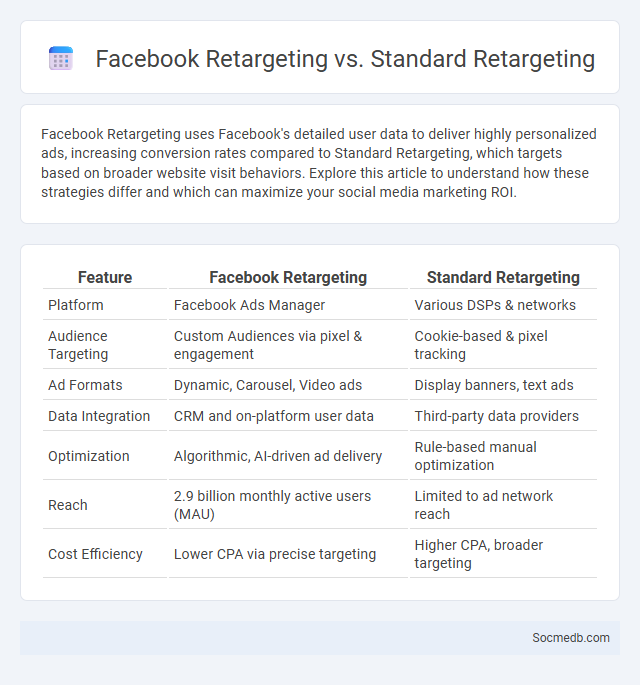
Photo illustration: Facebook Retargeting vs Standard Retargeting
Facebook Retargeting uses Facebook's detailed user data to deliver highly personalized ads, increasing conversion rates compared to Standard Retargeting, which targets based on broader website visit behaviors. Explore this article to understand how these strategies differ and which can maximize your social media marketing ROI.
Table of Comparison
| Feature | Facebook Retargeting | Standard Retargeting |
|---|---|---|
| Platform | Facebook Ads Manager | Various DSPs & networks |
| Audience Targeting | Custom Audiences via pixel & engagement | Cookie-based & pixel tracking |
| Ad Formats | Dynamic, Carousel, Video ads | Display banners, text ads |
| Data Integration | CRM and on-platform user data | Third-party data providers |
| Optimization | Algorithmic, AI-driven ad delivery | Rule-based manual optimization |
| Reach | 2.9 billion monthly active users (MAU) | Limited to ad network reach |
| Cost Efficiency | Lower CPA via precise targeting | Higher CPA, broader targeting |
Understanding Retargeting: Definition and Basics
Retargeting is a digital marketing strategy that targets users who have previously interacted with a brand's website or social media content, aiming to re-engage them with tailored ads. It relies on tracking technologies such as cookies and pixel tags to collect user behavior data and deliver personalized advertisements across platforms like Facebook, Instagram, and Google Ads. Businesses leverage retargeting to improve conversion rates, increase brand recall, and maximize return on ad spend by focusing marketing efforts on an already interested audience.
What is Facebook Retargeting?
Facebook Retargeting is a digital marketing strategy that targets users who have previously interacted with a brand's website or content by displaying personalized ads on their Facebook feed. This technique leverages Facebook Pixel data to track user behavior and segment audiences based on actions such as page visits, product views, or cart abandonment. By delivering highly relevant ads, Facebook Retargeting increases conversion rates and enhances return on ad spend (ROAS).
Standard Retargeting Explained
Standard retargeting targets users who have previously interacted with your website or social media content, delivering personalized ads to encourage conversions. By tracking visitor behavior through cookies or pixels, this strategy enhances ad relevancy and boosts return on investment (ROI) for your marketing campaigns. Your audience receives tailored messages that increase brand recall and drive repeat engagement effectively.
Key Differences: Facebook Retargeting vs Standard Retargeting
Facebook retargeting utilizes Facebook's vast user data and ad network to deliver personalized ads based on user interactions within the platform, enhancing engagement and conversion rates. Standard retargeting relies on cookies and pixel data from a wider range of websites, targeting users who have visited specific pages regardless of their social media activity. The key difference lies in Facebook retargeting's integration with social graph data, enabling more precise audience segmentation compared to the broader but less personalized approach of standard retargeting.
Platforms Supported: Where Each Retargeting Works
Facebook and Instagram excel in retargeting through their extensive user data and versatile ad formats, enabling personalized audience engagement across feeds, stories, and reels. Google Ads supports retargeting across the Google Display Network, YouTube, and Search, optimizing visibility through contextual and behavioral signals. LinkedIn specializes in B2B retargeting, leveraging professional data to target ads within feeds, messaging, and sponsored content.
Audience Targeting Capabilities
Social media platforms offer advanced audience targeting capabilities that allow precise segmentation based on demographics, interests, behaviors, and location. These tools help businesses deliver personalized content and ads, improving engagement and conversion rates. Utilizing these features enables You to reach the most relevant audience efficiently and maximize your marketing ROI.
Ad Formats and Creative Options
Social media platforms offer diverse ad formats such as carousel ads, video ads, and sponsored posts, each designed to maximize engagement and reach. Creative options include interactive elements like polls, augmented reality filters, and shoppable tags that enhance user interaction and drive conversions. Choosing the right combination of formats and creativity can optimize Your campaign performance and deliver measurable results.
Performance Metrics: Measuring Success
Performance metrics such as engagement rate, reach, impressions, and conversion rates provide critical insights into your social media success. Tracking metrics like click-through rates (CTR) and follower growth helps optimize content strategies for maximum impact. Analyzing these data points ensures you can measure return on investment (ROI) and refine campaigns to achieve business goals effectively.
Costs and ROI Comparison
Social media advertising costs vary significantly across platforms, with Facebook offering lower average cost-per-click (CPC) rates around $0.97 compared to LinkedIn's $5.26, affecting your overall marketing budget allocation. ROI depends on targeting precision and content relevance, where businesses see up to a 13% increase in conversion rates when optimizing campaigns for specific audiences. Monitoring key metrics like engagement rate, click-through rate (CTR), and cost per acquisition (CPA) helps maximize the return on your social media investments.
Choosing the Right Retargeting Strategy for Your Business
Selecting the right retargeting strategy for your business hinges on understanding your audience's behavior and engagement levels across social media platforms. Leveraging dynamic ads and segmented audience lists ensures higher conversion rates by delivering personalized content that resonates with your potential customers. Your success depends on continuous data analysis and optimization to maximize return on ad spend and improve brand recall.
 socmedb.com
socmedb.com